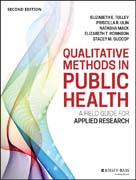
Qualitative Methods in Public Health: A Field Guide for Applied Research
Tolley, Betsy
Ulin, Pricilla
Robinson, Beth
Mack, Natasha
Succop, Stacey
International, Family Health
A real–world guide to conducting rigorous qualitative research Qualitative Methods in Public Health: A Field Guide for Applied Research provides a practical orientation to conducting effective qualitative research in the public health sphere. With thorough examination and simple explanations, this book guides you through the logic and workflow of qualitative approaches, with step–by–step guidance on every phase of the research. You?ll learn how to identify and make use of theoretical frameworks to guide your study, and then design the study to answer specific questions and achieve the research goals. Data collection, analysis, and interpretation are given close attention as the backbone of a successful study, and expert insight on reporting and dissemination helps you get your work noticed. This second edition features new examples from global health, including case studies specifically illustrating study design, web and mobile technologies, mixed methods, and new innovations in information dissemination. Pedagogical tools have been added to help enhance your understanding of research design and implementation, and extensive appendices show you how these concepts work in practice. Qualitative research is a powerful tool for public health, but it?s very easy to get it wrong. Careful study design and data management are critical, and it?s important to resist drawing conclusions that the data cannot support. This book shows you how to conduct high–quality qualitative research that stands up to review. Design robust qualitative studies and collect the appropriate data Translate your data into words without sacrificing accuracy Merge qualitative and quantitative data to tell the whole story Master the logistics of consent, interviews, focus groups, and more Effective public health programs require insight into the different contexts that affect behavior. A thorough understanding and appropriate application of qualitative research strategies is the difference between relevant and credible conclusions and pseudoscience. Qualitative Methods in Public Health shows you how to get it right every step of the way. INDICE: List of of Figures, Tables, and Boxes .List of Case Studies .Preface or Foreword .Acknowledgements .About the Authors .Chapter One .Invitation to Explore .Our Purpose .What Is Qualitative Research? .Getting Started .Chapter Two .The Language and Logic of Qualitative Research .Frameworks for Research: Paradigms, Theories and Conceptual Models .Using Qualitative Methods to Develop Theory .Substantive Theories and Conceptual Models .Standards for Qualitative Research .Chapter Three .Designing the Study .Background and Rationale .Developing Study Objectives .Using Documentary Sources .Data from Human Subjects .Data Collection Methods .Collecting Data .Analyzing the Data .Disseminating Results .Research Ethics: Decisions for the Protection of Study Participants .Other Considerations: Budget and Time .Chapter Four .Collecting Qualitative Data: .The Science and the Art .Observation .Interviews and Focus Groups .Structured Data Collection Techniques .Chapter Five .Logistics in the Field .Introduction to the Community: Building Rapport .Involving Policymakers and Change Agents .Developing the Field Team .Training .Field Materials .Pilot Testing .Field Logistics .Supervision and Monitoring .Generating Data Files .Transcription and Translation .Data Management and Storage .Timelines and Budgets .Chapter Six .Qualitative Data Analysis .Principles of Qualitative Data Analysis: Keeping the Research Purpose in Mind .Basic Steps in Qualitative Data Analysis .Step 1. Reading: Developing an Intimate Relationship with the Data .Step 2. Coding: Identifying the Emerging Themes .Computer Software .Step 3. Displaying Data: Distinguishing Nuances of a Topic .Developing Hypotheses, Questioning, and Verifying .Step 4. Data Reduction: Getting the Big Picture .Step 5. Interpretation .Chapter Seven .Disseminating Qualitative Research .Chapter Eight: Putting It into Words .Reporting Qualitative Research Results in Scientific Journals and Reports .The Role of Writing in Responsible Conduct of Research .Before You Write .Writing Your Article or Report .After You Write .Appendix One .Examples of Oral Consent Forms .Appendix Two .Topic Guides with Pictures .Appendix Three .Participant Observation Notes .Appendix Four .Sample Interviewer Training Program Agendas and Training Schedules .Appendix Five .Sample Budget Categories for Planning Qualitative Data Collection .Appendix Six .Coding Summary Report .Appendix Seven .Example of Data Analysis Memo .Appendix Eight .Where to Publish .Appendix Nine .Research Brief: Communicating Partial Protection of Voluntary Medical Male Circumcision .Appendix Ten .Who Is an Author? .Appendix Eleven .Sample Brochures to Share Qualitative Study Findings with Participating Communities .Appendix Twelve .Making Study Findings Accessible to Other Researchers
- ISBN: 978-1-118-83450-3
- Editorial: John Wiley & Sons
- Encuadernacion: Rústica
- Páginas: 352
- Fecha Publicación: 11/05/2016
- Nº Volúmenes: 1
- Idioma: Inglés
